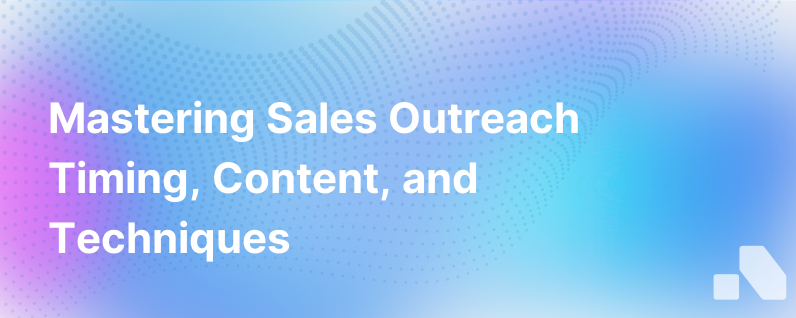The When What How Of Effective Sales Outreach
Published on November 4, 2023 by David Zhang
In the intricate dance that is modern sales, outreach can often feel like attempting to solve a Rubik's cube blindfolded. Each move must be deliberate, aligning with the varied colors of buyer personas, industry quirks, and the timing that dictates it all. Only when each element is perfectly aligned does the path to conversion become crystal-clear.
When done correctly, an effective sales outreach strategy can be the key that unlocks the potential for growth and customer acquisition. It's not just about making contact; it's about making contact at the right time, with the right message, through the right channel.
So let's break it down: When should you reach out? What should you say? And how should you say it? Here's your comprehensive guide to mastering the trinity of sales outreach.
I. Timing: The "When" of Sales Outreach
Timing is sometimes everything. It's crucial to understand that our prospects are humans first; busy professionals second. Consequently, outreach must tap into their schedules and rhythms, not interrupt or disregard them.
Understanding Your Prospect's Buying Cycle
- Pre-Research Awareness: Target prospects may not even be aware they need your solution. Seeking to inform rather than sell at this stage is often more appropriate.
- Active Solution Seeking: Once they start looking for solutions, it's time to present your value proposition.
- Decision-Making Phase: This is when to emphasize differentiation from competitors and reinforce your value.
Tracking Technographic and Firmographic Signals
Use data to drive your timing strategies. Tools that track when a company is growing, has secured funding, or is adopting complementary technologies can provide you with an ideal opening to reach out.
Leveraging Seasonality and Market Trends
Align your outreach with industry trends and seasonal shifts. For instance, budgeting season in many industries or financial year-ends might be opportune moments to make contact.
II. Messaging: The "What" of Sales Outreach
The substance of your outreach message determines whether it resonates with or repels your prospects.
Personalization: Beyond "Hi [First Name]"
Merely auto-filling names and company details doesn't cut it. Dig deeper, leveraging insights about prospects' pain points, initiatives they're leading, or achievements they're proud of.
Crafting a Compelling Narrative
- Pain Point Introduction: Speak to a challenge or opportunity that your prospect may be facing.
- Solution Presentation: Illustrate how your service/product can alleviate their pain points or capitalize on opportunities.
- Success Projection: Share results that other clients in similar situations have realized.
Value, Not Features
Always frame the conversation around the value you offer. Explain how your product or service improves the prospect’s life or business — this is what persuades, not a laundry list of features.
III. Method: The "How" of Sales Outreach
Sales outreach isn't much different from forging any human connection — the medium matters just as much as the message itself.
Choosing the Right Channel
The multitude of available communication platforms, from email and LinkedIn to cold calls and snail mail, necessitates a strategic choice.
- Email: Great for detailed, thought-out messages that provide value upfront. And with an open rate of up to 18% in most industries, it's a solid starting point.
- Phone Calls: Use them to convey urgency or when a human touch is indispensable.
- Social Media: Ideal for softer, more relational approaches that build visibility before the pitch.
- Direct Mail: Standing out in a digital age, it can be the surprise play that garners attention when used sparingly.
- Omni-Channel Outreach: The most effective strategies often deploy multiple coordinated channels, playing to the strengths of each.
Frequency and Follow-up
Persistence is key — but it's a thin line between persistence and nuisance. Adhering to a carefully plotted follow-up schedule increases the chances of a response without bordering on harassment.
- First Follow-up: 3 days after initial contact
- Subsequent Follow-ups: Gradually extending intervals, from weekly to bi-weekly.
Automation and Personal Touch
While sales outreach automation tools can scale your efforts, they must be used judiciously. Balance scheduled emails and auto-follow-ups with personalized touches and manual interventions.
Tailoring Your Approach to Your Buyer Persona
Sales outreach isn't a one-size-fits-all game. The seniority and role of the prospect influence how you frame your messaging and choose your communication channel.
Embracing Continuous Learning and Agility
The most successful salespeople regard each outreach as a learning opportunity. Analyze what worked and what didn't by tracking metrics like open rates, response rates, and conversion rates. Use this data to pivot and iterate on your strategies.
Conclusion
Effective sales outreach is an amalgamation of the perfect when, the persuasive what, and the nuanced how. As B2B sales become increasingly complex, this triad will continue to guide our discourses towards more engaging, impactful connections.
For those ready to embolden their sales outreach strategy with intelligent, data-driven insights, Aomni is your silent partner in the background. Harnessing powerful AI and real-time market analysis, it streamlines the creation of outreach that speaks directly to the heart of your prospect's challenges and ambitions. Through Aomni, the key to mastering intricate sales conversations becomes significantly more attainable.